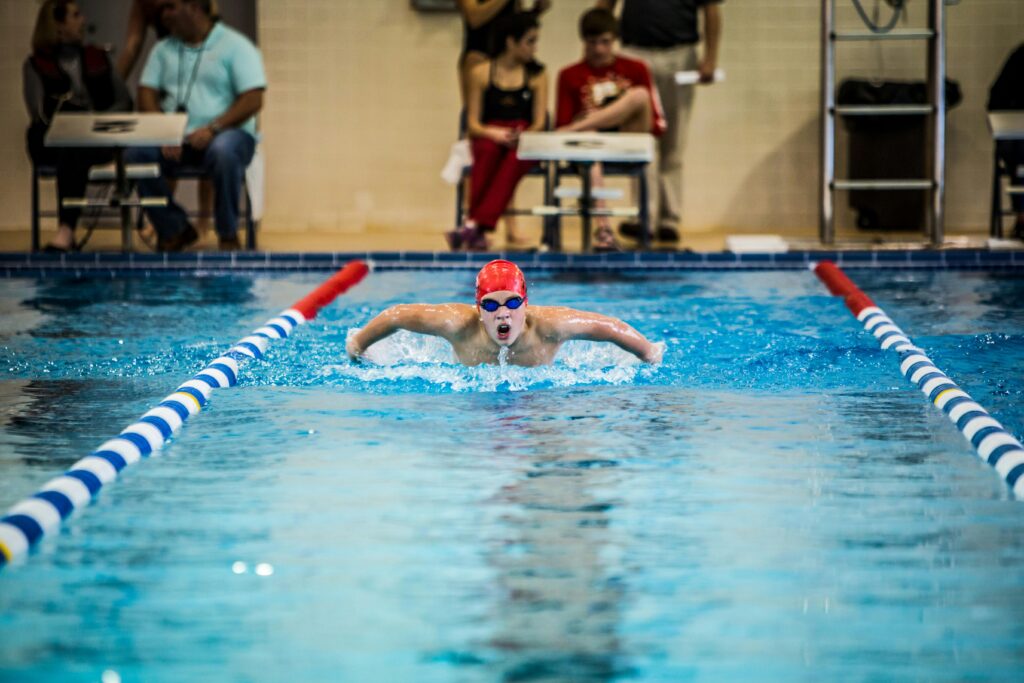Swimming and Building Muscle: Brief Overview
Swimming is often an underrated aspect of many training plans, typically seen as just a cardio workout. However, many people often wonder, does swimming build muscle? When I first started swimming twice a week alongside my regular strength training, I was curious about how it would impact my overall fitness. While swimming is great for cardiovascular health and conditioning, its effects on muscle growth are more complex.
Personally, while I primarily focus on building muscle through weightlifting, swimming has provided unexpected benefits that have enhanced my overall health training plan. In this article, we’ll explore the best strategies to gain muscle swimming. We will also explore how swimming can serve as a direct stimulus for muscle growth and how it can be effectively incorporated into a strength training routine to maximize results.
Does Swimming Build Muscle?
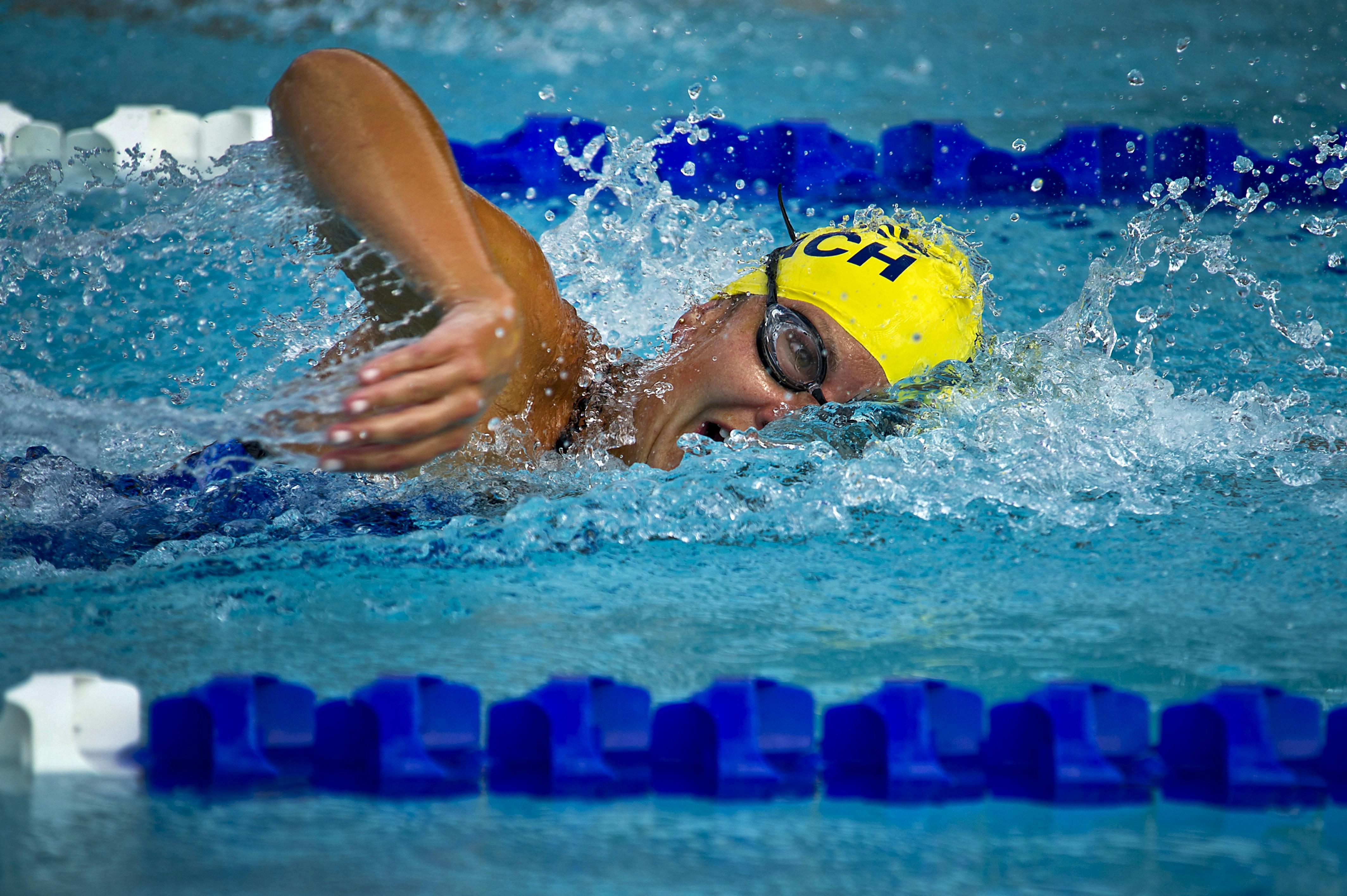
Swimming for Beginners
So, does swimming build muscle? For beginners or those untrained in physical fitness, swimming can indeed stimulate some muscle growth. This initial growth happens because the body is adapting to a new activity, which acts as a novel stimulus. The repetitive motions, coupled with the resistance provided by water, engage various muscle groups in ways they may not have experienced before. For example, strokes like freestyle target the shoulders, chest, and back, while the kicking motion activates the glutes, quads, and hamstrings. This can result in slight hypertrophy, particularly for individuals who are not accustomed to regular exercise.
Unfortunately, this initial stage of muscle growth is short. Once the body adapts to swimming’s repetitive nature and the constant resistance offered by water, further muscle growth stalls. This plateau occurs because swimming lacks a key principle for long-term muscle building: progressive overload.
In simple terms, progressive overload involves continuously challenging your muscles with increased resistance, intensity, or workload over time. Since swimming provides a constant level of resistance (the water), the muscles eventually stop receiving the stimulus needed for further growth.
I’ll dive deeper into progressive overload and why it’s essential for muscle building later in this article. For now, it’s worth noting that while swimming is excellent for endurance and overall fitness, it should be paired with strength training if your goal is significant muscle growth.
Muscle Fibers and Swimming
Another factor to consider is the type of muscle fibers swimming primarily engages. Swimming is largely an endurance-based activity that relies heavily on slow-twitch muscle fibers. These fibers are highly resistant to fatigue and ideal for sustained aerobic activities, but they don’t grow as significantly as fast-twitch fibers. These fibers are activated during short bursts of high-intensity exercise, like weightlifting or sprinting.
Slow-twitch fibers have a higher concentration of mitochondria, which provide energy through aerobic metabolism. This makes them perfect for prolonged activities like swimming. However, their focus on efficiency and endurance means they don’t hypertrophy—or increase in size—as much as fast-twitch fibers. This explains why swimmers often have lean, toned physiques rather than bulky muscles. Over time, unless combined with resistance training or high-intensity interval work, swimming alone is unlikely to develop significant muscle mass.
Muscle Hypertrophy for Swimming
Muscle hypertrophy, or the process where muscle fibers grow in size, occurs as a response to physical stress. When muscles experience micro-tears from high-stress activities, such as resistance training, they grow back stronger and increase in size. A key driver of this process is mechanical tension, which typically comes from lifting heavy weights or applying significant resistance to the muscles. For continued growth, you must gradually increase the demand on the muscles. This can be done through heavier resistance, more repetitions, or higher intensity. Without this ongoing challenge, muscle growth plateaus and further development halts.
Swimming, while a fantastic exercise for overall fitness and endurance, doesn’t naturally align with these principles of hypertrophy. The resistance provided by water, though effective for toning and cardiovascular health, is relatively low compared to the heavy loads required for significant mechanical tension. As a result, it can be challenging to stimulate long-term muscle growth with swimming alone.
That said, swimming can still be optimized to support hypertrophy. In the next section, I will give you strategies to gain muscle swimming and make it a more effective tool for building muscle.
What Strokes Target Which Muscles
Check out this video from Youtube Channel MySwimPro, which goes into detail on how to perform all four strokes
Here is an overview of the different strokes in swimming and which muscle groups they target.
Freestyle (Front Crawl)
Freestyle is the most common and efficient swimming stroke, characterized by a flutter kick and alternating arm movements that create a smooth, streamlined motion through the water.
This stroke primarily works the shoulders, chest, and core as the arms pull through the water and the body rotates side to side. The back muscles, including the lats, are engaged during the pull phase, while the legs contribute propulsion through a consistent flutter kick. The core muscles are essential for maintaining balance and stability during the body’s rotation.
Backstroke
Backstroke is performed on your back with a flutter kick and alternating arm movements. This is similar to the freestyle, but in reverse. It is characterized by its unique body position and rhythmic arm strokes while keeping the face above the surface for breathing.
This stroke targets the back muscles, particularly the lats and trapezius, as the arms sweep through the water. The shoulders and arms are heavily engaged during the recovery and pull phases, helping to maintain rhythm and propulsion. The core muscles are crucial for stabilization to keep the body aligned and floating smoothly. This stroke is also less strenuous on the neck and shoulders, making it a good option for those with joint concerns.
Breaststroke
Breaststroke is one of the slower swimming strokes, but it is highly technical, requiring simultaneous arm and leg movements. The arms sweep outward and inward in a circular motion, engaging the chest and shoulders.
The kick emphasizes the inner thighs and glutes, while the core works to maintain alignment and rhythm. This stroke places significant demand on the legs for propulsion, making it a great lower-body workout. Proper timing and coordination between the arms and legs are essential for effective propulsion and reduced drag.
Butterfly
The butterfly is one of the most demanding strokes, requiring strength, power, and coordination. It involves a dolphin kick with both legs moving in unison, paired with a simultaneous arm pull and recovery.
This stroke heavily focuses on the chest and shoulders, as the arms perform powerful sweeping motions to propel the body forward. The triceps are engaged during the arm recovery phase, while the core works to stabilize the body and support the undulating movement. The legs play a crucial role in propulsion, and maintaining proper rhythm is key to sustaining this energy-intensive stroke.
Each swimming stroke offers a full-body workout while emphasizing different muscle groups. Incorporating a variety of strokes into your swim sessions can help ensure balanced muscle engagement and improved overall strength and endurance.
How to Build Muscle Swimming
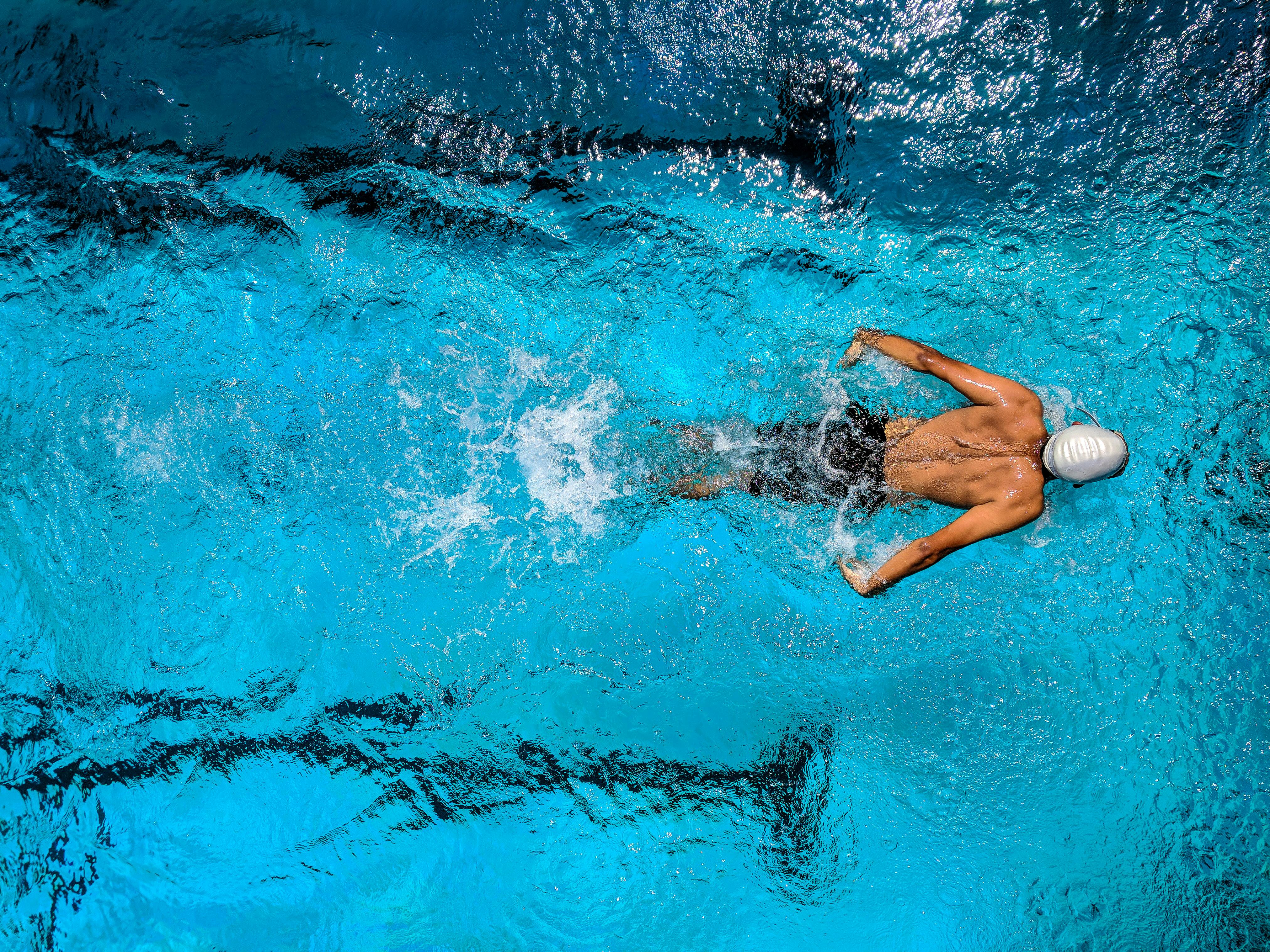
Progressive Overload
As mentioned earlier, progressive overload is the key principle for muscle growth and strength development, whether in weight training or swimming. It means gradually increasing the demands on your muscles over time to ensure they adapt, grow, and become stronger. When the body is stressed, it repairs and rebuilds muscle fibers. However, this process only continues if you consistently increase intensity, volume, or resistance to stimulate further growth.
In swimming, progressive overload means challenging your muscles by increasing resistance (using paddles, swim parachutes, or drag socks), adding more repetitions or sets, or training more frequently. This pushes your muscles to work harder, creating the tension needed for hypertrophy. However, swimming can be tricky since water provides constant resistance, and fatigue may limit high-intensity efforts.
With careful planning and gradual increases in resistance and effort, though, it’s possible to achieve progressive overload. Without it, your body will plateau, and muscle growth will stagnate.
Increase Resistance
To mimic the progressive overload principle, gradually introducing tools that add resistance is key to muscle growth. Start with swimming paddles, drag socks, or a swim parachute to increase the tension in the water. Gradual progression is essential to avoid overloading your muscles too quickly, which can lead to poor form, fatigue, or injury.
For example, use paddles for short sprints during your first workout, focusing on maintaining proper form and control. In your next session, increase the challenge by lengthening your sprints or adding drag socks for more resistance. Progressively increasing resistance gives your muscles time to adapt, ensuring steady growth and reducing the risk of overtraining. Adding too much resistance too soon can compromise your technique, preventing effective muscle engagement and increasing the risk of burnout or strain.
Short, Intense Sets
Focusing on short, high-intensity sets is more effective to gain muscle swimming because it prioritizes fast-twitch muscle fibers. These are responsible for strength and size.
Perform sprints lasting 15–30 seconds at maximum effort, followed by brief rest periods to recover. This high-intensity approach mimics resistance training by creating the mechanical tension and fatigue needed to stimulate muscle growth.
Weighted Training in Water
Incorporating weighted exercises using water-friendly tools, like aquatic dumbbells or resistance bands, adds an extra layer of resistance for muscle growth. Movements such as underwater presses, rows, or lateral raises mimic the benefits of gym weightlifting while engaging stabilizing muscles due to the water’s dynamic resistance. Start with lighter aquatic dumbbells to learn the movement patterns and focus on controlled form. Gradually increase the weight over time or switch to thicker resistance bands to provide a stronger stimulus.
Weighted exercises in water are especially valuable because they reduce impact on joints, making them ideal for muscle recovery from injuries or seeking low-impact training. Tracking your progress by logging sets, reps, and resistance levels ensures your muscles face consistent challenges, leading to steady adaptations and growth.
Perfect Your Form
Perfect swimming technique ensures muscles are fully engaged throughout each stroke, maximizing efficiency and muscle activation. For freestyle or butterfly, focus on maximizing pull strength while maintaining tight core activation to stabilize your movements. Efficient form ensures that the workload targets your muscles rather than being wasted through poor mechanics.
To improve your technique, ask someone to record your sets or use an underwater camera to evaluate your form. Reviewing footage helps identify areas for improvement, such as uneven strokes or insufficient pull depth. Small adjustments based on these observations can significantly enhance your performance and ensure consistent muscle engagement. Consider asking a coach or experienced swimmer for feedback, as they can spot errors you might miss.
By emphasizing resistance, intensity, and proper technique, swimming can become a more effective part of a muscle-building routine. Keep sets short to avoid fatigue becoming the limiting factor and ensure consistent muscle activation.
Swimming Routine to Build Muscle
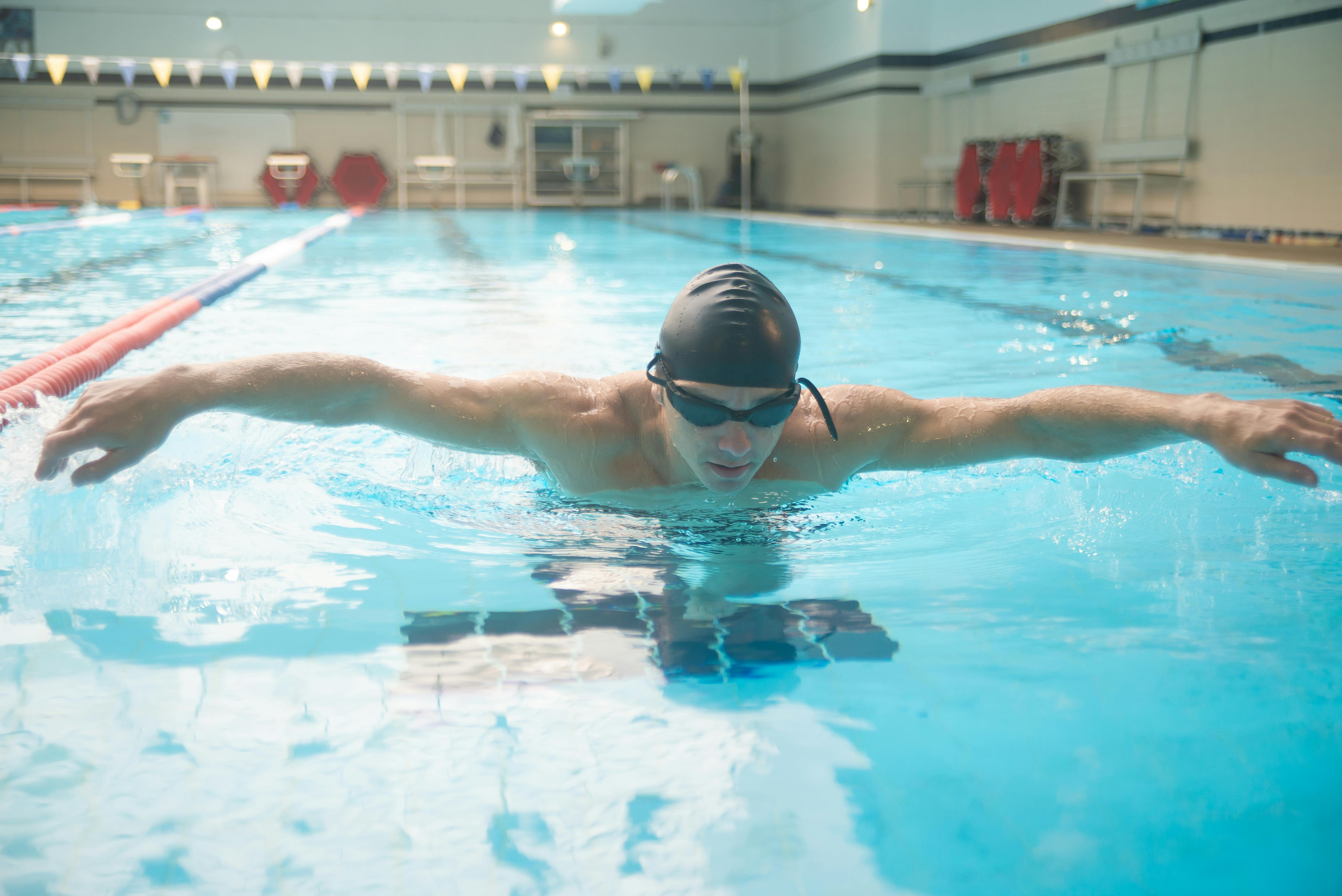
Based on the principles above, here is an example of a swimming routine to build muscle.
WARMUP
200m Easy Freestyle: Swim 8 lengths of freestyle at a comfortable pace to warm up.
Key Benefit: Prepares muscles and joints for intense activity, reducing injury risk.
100m Kick: Hold a kickboard and swim 4 lengths using only leg kicks.
Technique Tip: Keep your legs straight and kick from the hips, not the knees.
100m Pull: Place a pull buoy between your legs and swim 4 lengths using only your arms.
MAIN SET 1 – POWER PROGRESSION
Perform four sets of:
25m Sprints with Paddles: Perform a short and fast swimming sprint for 1 length. Alternate between freestyle and butterfly (or butterfly arms with a flutter kick if butterfly is too challenging).
Progression Tip: Start with smaller paddles and gradually increase paddle size every 2–3 weeks to build strength.Once you’re comfortable, add drag socks to further increase resistance.
Key Benefit: Short sprints target fast-twitch muscle fibers, crucial for strength and explosive power.
MAIN SET 2: RESISTANCE LADDER
Perform three sets of:
25m Breaststroke with Resistance Parachute: Swim 1 length of the pool doing breaststroke while towing a parachute. Focus on controlled arm movements to engage the chest.
25m Freestyle with Parachute: Swim 1 length of the pool towing a parachute for additional resistance.
25m Explosive Sprint Without Resistance: Swim all-out for 1 length of the pool to maximize speed and power.
Progression Tip: Begin with a small parachute and increase its size or add an additional set every few weeks. Keep rest periods between rounds to 30 seconds or less as you build endurance.
Key Benefit: This set simulates weightlifting by progressively overloading your muscles with resistance.
STRENGTH SET
Perform two sets of:
Aqua Dumbbell Press (10–15 reps): Stand in the water and perform chest presses, pushing dumbbells forward.
Form Tip: Keep your shoulders down and engage your core to stabilize.
Underwater Dumbbell Chest Press (10–15 reps): Fully submerged, perform chest presses by extending your arms upward.
Form Tip: Avoid locking out your elbows at the top for consistent tension.
Band Rows (10–15 reps): Use a resistance band and pull it toward your torso in a controlled motion.
Form Tip: Squeeze your shoulder blades together at the peak of the movement.
Aqua Dumbbell Bicep Curls (10–15 reps): Stand in the water and curl dumbbells toward your shoulders.
Progression Tip: Gradually increase dumbbell weight or reps weekly.
Treading Water with Dumbbells (30 seconds): Maintain a vertical position using your legs and arms while holding dumbbells.
Beginner Tip: Start without dumbbells if you find this challenging.
Key Benefit: These movements mimic gym-based resistance exercises and target muscle growth directly.
COOLDOWN
100m Easy Freestyle: Swim 4 lengths at a relaxed pace to lower your heart rate.
100m Choice Stroke: Swim 4 lengths using your favorite stroke for active recovery.
Optional Stretching: Focus on the shoulders, chest, and legs to aid recovery.
KEY POINTS
Rest fully between sets to maintain maximum intensity: Resting fully between sets helps your muscles recover and perform at their best. Aim for 2-3 minutes of rest after each set to replenish energy and maintain intensity.
Focus on explosive movements rather than endurance: Explosive movements activate fast-twitch muscle fibers for strength and size. Swim sprints at maximum speed, focusing on quick, powerful strokes, rather than pacing yourself.
Maintain proper form even when fatigued: Maintaining proper form prevents injury and ensures the right muscles are targeted. If your form starts to slip, slow down and focus on controlled, deliberate movements.
Start with lighter resistance tools and progress over time: Starting with lighter resistance reduces the risk of injury while building strength. Gradually increase resistance, such as using larger paddles or heavier dumbbells, as you get stronger.
Swimming for Building Muscle: An Alternative Method
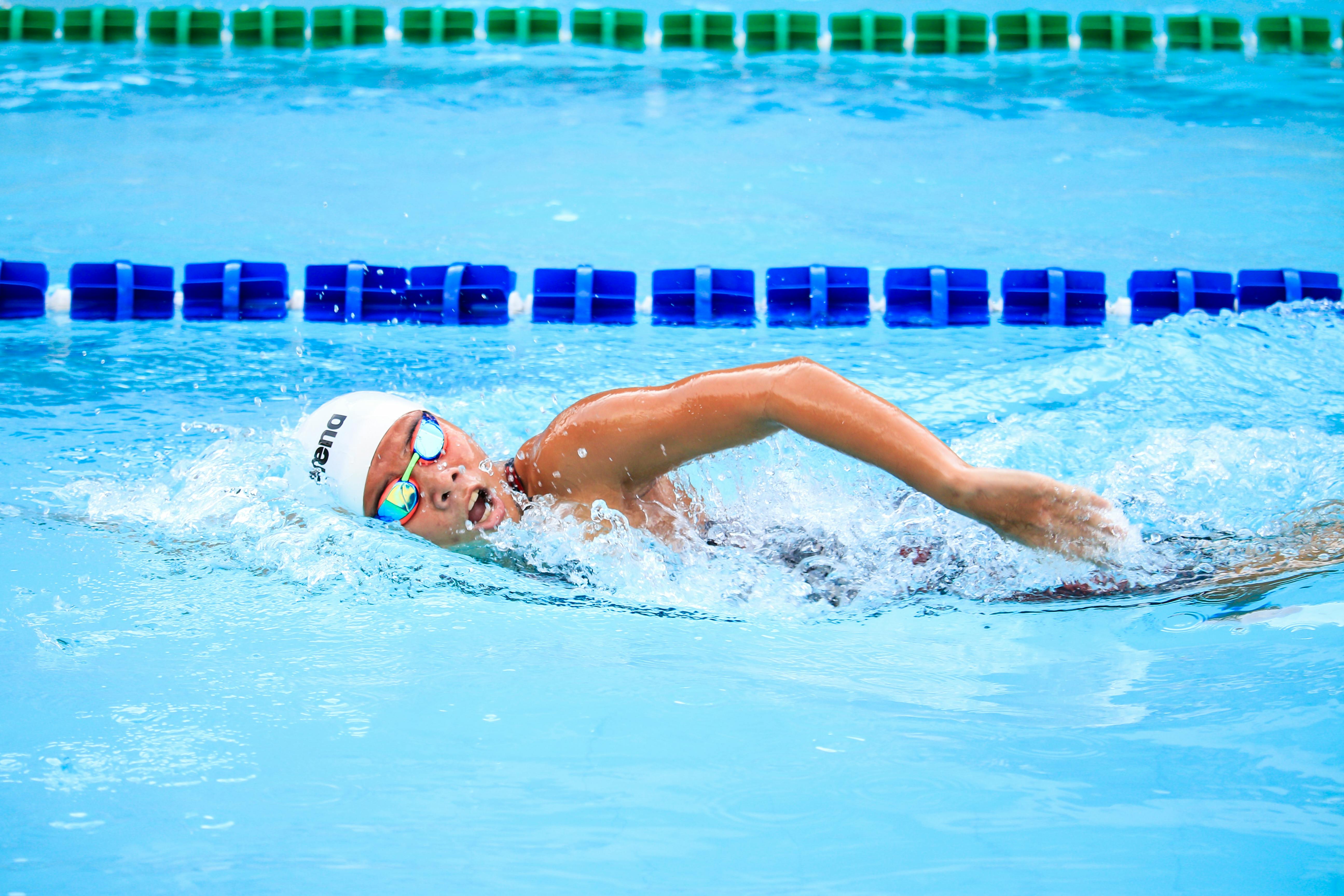
Benefits of Combining Swimming with Weight Lifting
An effective approach to gain muscle swimming is to use it as a supplement to strength training, rather than replacing it entirely. While swimming can stimulate some muscle growth, it is more beneficial when combined with strength training. Swimming enhances muscular endurance and provides active recovery, which supports muscle growth without straining the body. Instead of replacing strength training, swimming better serves as a complement to it by improving cardiovascular health and increasing flexibility. It also offers a low-impact way to recover between weightlifting sessions.
Together, these activities create a synergistic effect. Strength training stimulates muscle growth by increasing mechanical tension and muscle fiber recruitment. Swimming promotes active recovery and prevents overtraining by offering a full-body, low-impact workout. This combination optimizes muscle growth while improving cardiovascular endurance, flexibility, and overall conditioning. The circulation boost from swimming helps remove metabolic waste, while strength training continues to provide the necessary stimulus for muscle adaptation and growth.
How to Use Swimming for Muscle Recovery
Using swimming as a tool for recovery and endurance is highly effective, but it serves a different purpose than the muscle-building workout described above. To use swimming for these purposes, focus on low-intensity, steady-state swims rather than high-resistance sprints or explosive movements.
For recovery, swimming offers a low-impact way to promote blood circulation, which helps reduce soreness and speed up the removal of metabolic waste from muscles. This can be particularly helpful after intense weight training sessions, as the gentle movement in the water aids in loosening tight muscles and preventing stiffness. Engaging in an easy swim with relaxed strokes allows your muscles to move without the added stress of weightlifting. This is helpful for providing active recovery without overtaxing your body.
Personally, I get very sore after a tough leg or upper body workout. A light swim afterwards or the next day drastically improves my muscle recovery and reduces soreness.
Other Benefits of Swimming
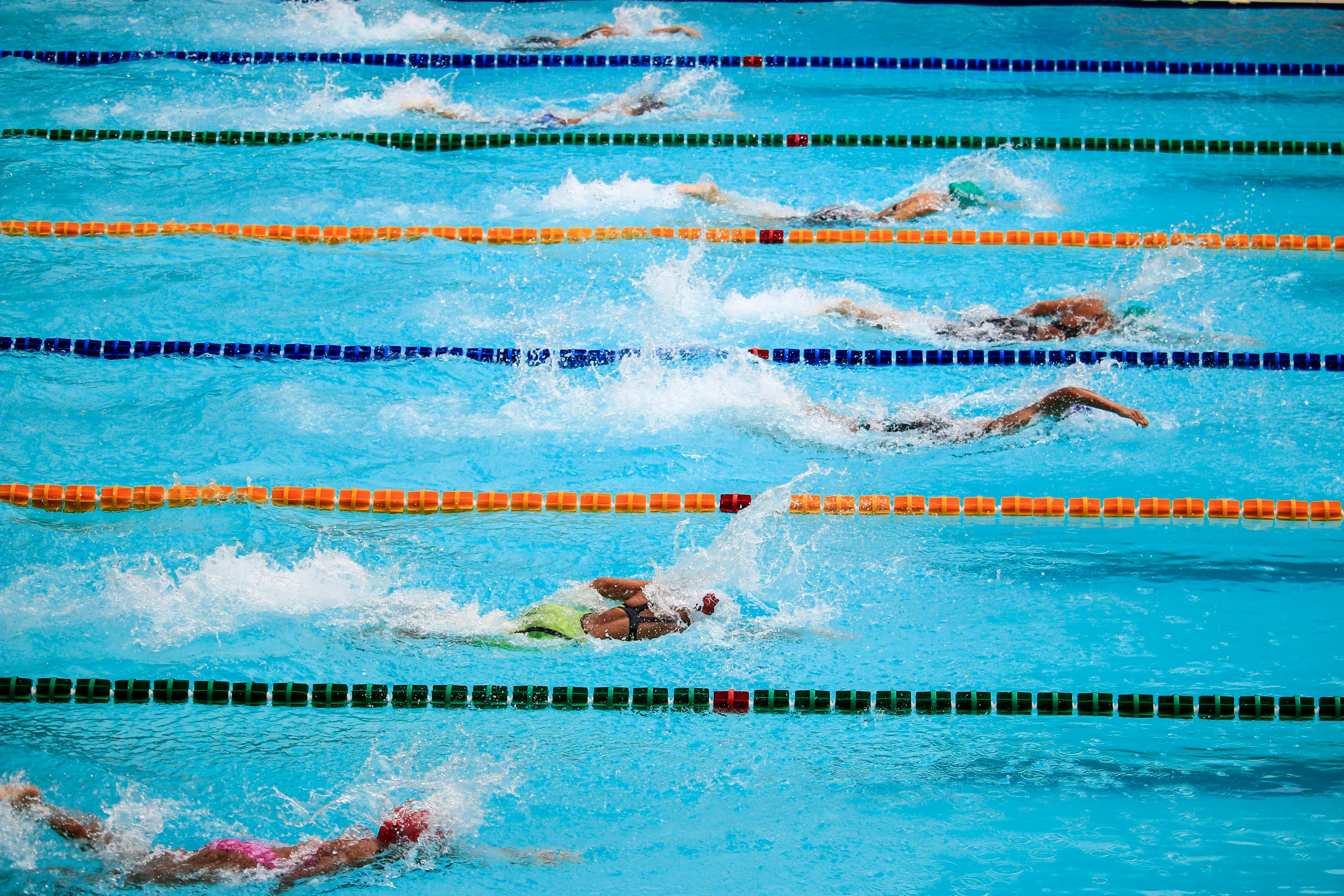
Increases Lung Capacity
Swimming is an effective way to increase lung capacity due to the unique demands it places on the respiratory system. During swimming, especially in strokes like freestyle and butterfly, swimmers must maintain a consistent, controlled breathing pattern while exerting themselves physically. This requires the lungs to work more efficiently to deliver oxygen to the body while removing carbon dioxide.
Holding the breath during certain strokes, combined with deep inhalations and controlled exhalations, helps expand the lungs’ capacity over time. As swimmers train, their diaphragm becomes stronger, and lung function improves. This allows for deeper breaths and increased oxygen intake, benefiting overall athletic performance and endurance.
Injury Prevention
Swimming is a low-impact exercise that places minimal stress on the joints, making it an ideal choice for active individuals who want to reduce the risk of overuse injuries. This makes it particularly beneficial for those who lift heavy weights regularly, as it allows them to maintain a high level of physical activity while giving their muscles and joints a break.
Unlike running, which can be energy consuming and hard on the body long-term, swimming offers a gentler alternative. The buoyancy of the water supports the body and minimizes the risk of impact-related injuries. This makes swimming a superior option for individuals seeking a full-body workout that’s easy on the joints while still providing cardiovascular benefits.
Core Stability
Swimming requires constant activation of the core muscles to maintain proper body position and streamline movement through the water. This consistent engagement of the core helps improve balance, coordination, and posture, all of which are vital for maintaining proper form during strength training exercises.
A strong, stable core also enhances your performance in compound lifts such as squats, deadlifts, and overhead presses, where core stability is crucial for generating power and preventing injury.
Nutrition for Swimming

Eat Enough Calories
When asking “does swimming build muscle,” it’s important to recognize the nutrition side of it. If you add swimming to your fitness regime, your body will demand more energy due to the physical activity involved, especially at higher intensities. Swimming, particularly when performed with speed and power, can burn a significant amount of calories. As a result it is essential to ensure you’re in a calorie surplus—consuming more calories than your body burns. This extra energy is vital for muscle repair and growth, even if swimming is your primary training method.
A calorie surplus provides the necessary fuel to repair the micro-tears in your muscles caused by the stress of swimming. Without this surplus, your body will struggle to build muscle, as it will be forced to use available energy for basic bodily functions instead of muscle recovery and growth. To achieve this surplus, focus on nutrient-dense foods like lean proteins (chicken, fish, tofu), healthy fats (avocados, nuts, olive oil), and complex carbohydrates (whole grains, sweet potatoes, vegetables). These foods offer the energy needed for your training and the building blocks for muscle repair.
Protein Intake
Protein intake is especially crucial in this process as it aids in the repair and rebuilding of muscle tissue. Aim to consume around 0.8-1 gram of protein per pound of body weight for best results. Try to spread protein consumption throughout the day, with a focus on post-swim recovery, to optimize muscle recovery and support growth. However, consuming significantly more protein than your body needs won’t provide additional benefits, as the excess is typically excreted or stored as fat.
By maintaining a calorie surplus and consuming the right balance of macronutrients, you’ll support muscle development and improve your performance in the pool, even without a structured weight lifting plan.
FAQ
While swimming helps with body toning and endurance, it doesn’t directly create a V-taper physique. People with V-tapers may be naturally good swimmers, but achieving this look requires specific strength training for the back, shoulders, and arms, along with fat loss to reveal muscle definition.
Swimming builds muscle endurance and tones muscles, but it doesn’t bulk you up like weightlifting. It helps maintain lean muscle mass and improves overall strength, making it great for conditioning, but it won’t produce significant muscle growth like resistance training.
Yes, swimming can help build muscle even if you have a fast metabolism, though it may not lead to significant hypertrophy like weightlifting. It supports lean muscle development by engaging multiple muscle groups and improving endurance. To see muscle growth, pairing swimming with strength training and adequate nutrition is key for those with a fast metabolism.
Swimming can build muscle mass faster than biking or running because it engages multiple muscle groups at once, including the upper body, core, and legs. The resistance of water provides a natural form of strength training, helping to build muscle while improving cardiovascular fitness. Unlike biking or running, which primarily target the lower body, swimming offers a full-body workout that promotes overall muscle development.
Final Thoughts on Swimming for Building Muscle
In the end, the question “does swimming build muscle” is more complex than it might seem. Swimming alone may not replace the gains from strength training, it’s a highly effective tool for enhancing muscle endurance, supporting recovery, and preventing injury. If you are trying to build muscle as a beginner, swimming is a fun activity that can be helpful for speeding up your progress. By incorporating swimming into your training plan and combining it with progressive overload and proper nutrition, you’ll unlock greater muscle growth potential and overall fitness. This synergistic approach maximizes muscle development by addressing both strength and cardiovascular fitness, optimizing the body’s ability to recover and adapt to training stress.
Moreover, the full-body engagement of swimming complements resistance training by activating stabilizing muscles and improving coordination. contributing to more balanced and functional strength. Ultimately, incorporating swimming into your training routine enhances the overall training stimulus, leading to superior results overall.
